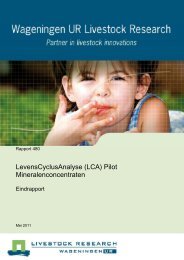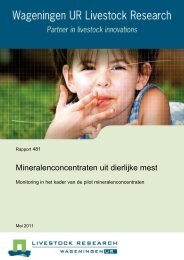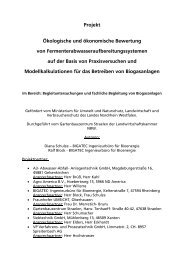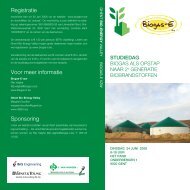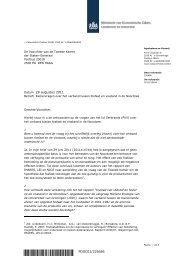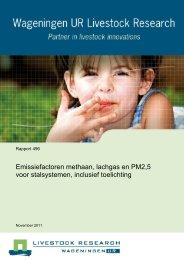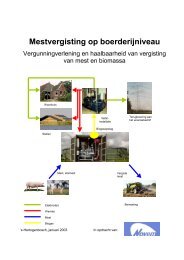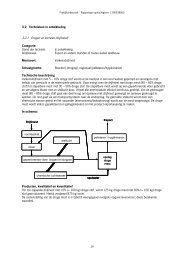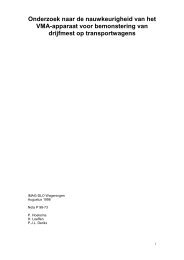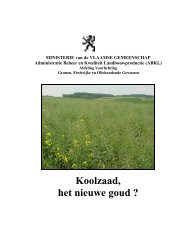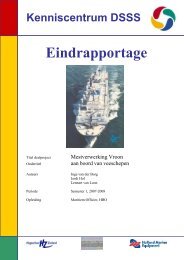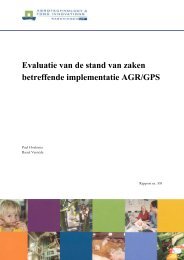Monitoring methane and nitrous oxide reduction by manure treatment
Monitoring methane and nitrous oxide reduction by manure treatment
Monitoring methane and nitrous oxide reduction by manure treatment
You also want an ePaper? Increase the reach of your titles
YUMPU automatically turns print PDFs into web optimized ePapers that Google loves.
2 Required information for NIR<br />
Report 627<br />
The National Inventary Report (NIR) documents the annual greenhouse gas emission inventory in<br />
accordance with the Guidelines provided <strong>by</strong> the United Nations Framework Convention on Climate<br />
Change (UNFCCC), the Kyoto Protocol <strong>and</strong> the European Union’s Greenhouse Gas <strong>Monitoring</strong><br />
Mechanism. Emission data in the NIR are calculated according to the protocols of the National System<br />
<strong>and</strong> documented in Common Reporting Format (CRF) spreadsheet files, which can be found on<br />
www.greenhousegases.nl. <strong>Monitoring</strong> protocols, describing methodologies <strong>and</strong> working processes for<br />
estimating greenhouse gas emissions including the activity data <strong>and</strong> emission factors to be used for<br />
the report, are also available at this website. The protocols are yearly updated (if needed). About 40<br />
monitoring protocols are valid at present in the Netherl<strong>and</strong>s. In connection with this study protocols for<br />
CH4 <strong>and</strong> N2O from Manure management <strong>and</strong> N2O from Agricultural soils are relevant.<br />
2.1 CH4 from <strong>manure</strong> management<br />
Methane emissions from animal <strong>manure</strong> are caused <strong>by</strong> fermentation processes that occur in<br />
anaerobic conditions. These conditions generally occur when storing liquid <strong>manure</strong> in <strong>manure</strong> cellars<br />
under the animal houses <strong>and</strong> in <strong>manure</strong> storage facilities outside the animal houses. Methane<br />
formation depends on storage conditions, such as storage period <strong>and</strong> temperature. There is a<br />
constant input of <strong>manure</strong> in the <strong>manure</strong> cellar <strong>and</strong> the volume of <strong>manure</strong> in the cellar increases up to<br />
the point where it is emptied, <strong>and</strong> the <strong>manure</strong> is distributed over the l<strong>and</strong>, or up to the point where the<br />
<strong>manure</strong> is transferred to the <strong>manure</strong> storage facility outside the animal house. The <strong>methane</strong> emissions<br />
increase as the amount of <strong>manure</strong> that is (still) in the storage facility (= inocculation) increases, as the<br />
<strong>manure</strong> temperature rises <strong>and</strong> the <strong>manure</strong> is stored for longer periods (Zeeman, 1994). The <strong>methane</strong><br />
emissions from <strong>manure</strong> also depend on the chemical composition of the <strong>manure</strong>, primarily the amount<br />
of organic matter.<br />
Calculation method<br />
Methane emissions from <strong>manure</strong> are basicly calculated from the number of animals <strong>and</strong> countryspecific<br />
emission factors. First the amount of <strong>manure</strong> is calculated annually for each animal category<br />
<strong>and</strong> each <strong>manure</strong> management system, from the number of animals per category <strong>and</strong> the amount of<br />
<strong>manure</strong> per animal. Then the country-specific emission factor per kg <strong>manure</strong> is calculated for each<br />
animal category <strong>and</strong> <strong>manure</strong> management system. Multiplying the emission factor <strong>and</strong> annual <strong>manure</strong><br />
production results in the annual <strong>methane</strong> emissions from <strong>manure</strong> storage. The total CH4 emissions<br />
from <strong>manure</strong> management are calculated <strong>by</strong> adding the CH4 emissions per animal category <strong>and</strong><br />
<strong>manure</strong> management system.<br />
Emission factors<br />
The formula for calculating the emission factor is:<br />
EFij = VSij * Boij * MCFj * <strong>methane</strong> density (0.67 kg/m 3 )<br />
EFij : emission factor (kg CH4/kg <strong>manure</strong>) per animal category (i) <strong>and</strong> <strong>manure</strong> management system (j)<br />
VSij : fraction of volatile solids (kg VS/kg <strong>manure</strong>) produced <strong>by</strong> animal category (i) <strong>and</strong> <strong>manure</strong> management<br />
system (j)<br />
B0ij : maximum <strong>methane</strong> production potential (m 3 CH4/kg VS) for the <strong>manure</strong> produced <strong>by</strong> animal category<br />
(i) <strong>and</strong> <strong>manure</strong> management system (j)<br />
MCFj : <strong>methane</strong> conversion factor for a <strong>manure</strong> management system j (% of B0)<br />
2





